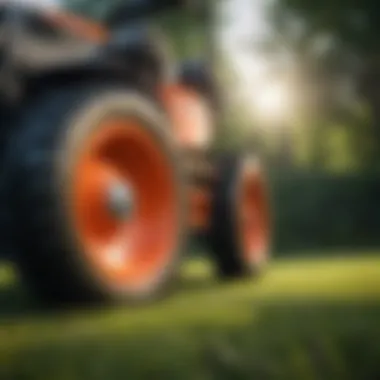Understanding the Cost of Lawn Rolling: A Comprehensive Guide


Overview of the Topic
Definition and Importance
Lawn rolling involves the use of a heavy cylindrical tool to flatten the surface of your lawn. This process improves the overall health of the grass and contributes to better air circulation and soil contact. An evenly rolled lawn can enhance the aesthetic appeal and functional usability of outdoor spaces. Many homeowners and property managers consider it an essential part of lawn care, especially after aeration or the laying of new sod.
Current Trends
The popularity of lawn rolling is rising as more people take interest in maintaining healthy and vibrant landscapes. Recent trends show an increased use of eco-friendly materials in lawn care practices. Instead of traditional steel rollers, some homeowners choose water-filled rollers or those made from sustainable resources. Moreover, there's a growing culture of DIY lawn maintenance on social media, leading to a more informed public.
Key Techniques and Practices
Step-by-Step Guide
- Preparation of the Lawn: Ensure the lawn is mowed and free of debris. This sets the stage for effective rolling.
- Soil Moisture Assessment: Check the moisture levels of the soil. Ideally, the soil should be moist but not too wet. Too much moisture can lead to soil compaction.
- Roll the Lawn: Start rolling in an overlapping pattern. This ensures even coverage and prevents damage to the grass.
- Post-Rolling Care: Avoid heavy foot traffic for a few days post-rolling. This helps the grass to recover and settle.
Tools and Equipment Needed
- Lawn Roller: Available in various types, including manual and tow-behind models.
- Soil Moisture Meter: To ensure your lawn has the right moisture before rolling.
- Mower: For initial lawn cutting.
- Rake: To clear away any sticks or rocks that could interfere with the process.
Challenges and Solutions
Common Obstacles
- Soil Compaction: Over-rolling can lead to soil compaction, which negatively affects grass health. It is crucial to monitor the frequency of rolling.
- Weather Dependence: The effectiveness of rolling can depend heavily on weather conditions and soil moisture.
Innovative Solutions
- Smart Technology Usage: Some homeowners are adopting smart lawns management systems, which include moisture sensors and automated rolling systems. These allow for precise control over lawn rolling schedules, based on real-time data.
- Alternative Methods: In some cases, using a vibrating roller may provide efficiencies where standard rollers do not work as well.
"Maintaining a healthy lawn is not just about aesthetics; it’s about fostering a thriving ecosystem in your own backyard."
Deciding whether to invest in lawn rolling requires careful consideration of costs, benefits, and personal commitment to lawn care. Understanding these aspects will help inform decisions in maintaining a healthy landscape.
Foreword to Lawn Rolling
Lawn rolling is an often-overlooked practice in turf maintenance that can have significant benefits when executed properly. Its importance lies in both the cosmetic and health aspects of the lawn. Proper rolling techniques can help avoid potential issues such as uneven surfaces and soil compaction. This introduction aims to elucidate the factors that contribute to the decision of whether to roll a lawn, and why understanding the costs involved is essential for anyone interested in optimal lawn care.
Definition and Purpose
Lawn rolling refers to the process of using a heavy cylindrical roller over the surface of the lawn. The purpose is multifaceted. Primarily, it aims to smooth out the lawn and improve its overall appearance. By flattening bumps and filling in holes, it creates a more even surface that is visually appealing. This practice also plays a critical role in soil compaction, which enables the soil to facilitate better moisture absorption, root growth, and overall lawn health.
Moreover, lawn rolling has particular applications surrounding seed germination. When seeds are sown, rolling the area can enhance seed-to-soil contact. This essential interaction can increase the chances of successful germination and rapid establishment of new grass.


Lawn Rolling Techniques
There are different techniques involved in lawn rolling, which can be classified mainly into manual and motorized methods. Each technique has its own pros and cons, depending on specific lawn needs and the scope of work.
- Manual Rollers: These are typically smaller and can be easier to handle for compact spaces. They require physical effort, making them suitable for DIY enthusiasts who prefer hands-on work. A manual roller can be especially beneficial for localized application, like around flower beds or other sensitive areas.
- Motorized Rollers: These machines allow for larger areas to be covered quickly. While they may require a higher initial investment, motorized rollers are often more efficient for extensive lawns. For larger properties, motorized equipment can save considerable time and labor.
Both methods require attention to detail, particularly regarding weight and moisture content in the soil. Rolling a wet or overly dry lawn can lead to undesirable outcomes, such as further compaction or turf damage. Evaluating the lawn's condition beforehand remains a critical consideration, ensuring that the chosen technique aligns with desired results.
Factors Influencing Lawn Rolling Costs
Understanding the costs associated with lawn rolling is important for anyone looking to maintain their landscaping efficiently. These costs can vary widely based on several factors. Being informed about what influences these expenses helps in budgeting and making decisions that suit your lawn's needs. This section will break down these factors, which include the type of rolling equipment used, labor costs, the size of the lawn, and regional pricing variations.
Type of Rolling Equipment
Manual Rollers
Manual rollers are a common choice for many homeowners. One key characteristic is their simplicity. Users can easily operate these devices without needing specialized skills or machinery. This makes manual rollers a beneficial option for those who enjoy hands-on work. They are generally less expensive than motorized options.
A unique feature of manual rollers is that they allow for more precise control. Since the user propels the roller themselves, they can adjust the pressure based on different areas of the lawn. However, they require more physical effort, which can be a disadvantage for some, especially over larger lawns.
Motorized Rollers
Motorized rollers offer another approach. They require no physical exertion from the user, which allows them to cover larger areas more quickly. This type of equipment is beneficial for those with bigger lawns or for professionals who roll lawns frequently. The main advantage of motorized rollers lies in their efficiency.
A unique feature is their ability to apply consistent pressure across the lawn. This consistent application can lead to better results in lawn health. However, motorized rollers come at a higher cost and may require maintenance, which adds to overall expenses.
Labor Costs
Professional Services vs. DIY
When considering labor costs, the choice between hiring professionals or doing it yourself (DIY) is crucial. Hiring a professional service is often seen as a premium option. It comes with expertise and usually provides better results, especially for those unfamiliar with proper lawn care techniques. Professional services also save time, which can be an important factor for busy individuals.
On the other hand, DIY lawn rolling can be more cost-effective. Renting the equipment is generally cheaper than hiring external help. However, this option requires a time commitment and some knowledge of lawn care. Striking a balance between cost and quality is essential when choosing between these two pathways.
Size of the Lawn
The size of the lawn plays a significant role in overall costs. Larger lawns require more time, equipment, and sometimes more physical effort. This can lead to increased labor costs, whether professional or DIY. Moreover, larger areas may necessitate renting more powerful machinery, further affecting the cost. Conversely, smaller lawns might incur lower costs, as they can be rolled quickly and easily.
Regional Pricing Variations
Pricing can significantly vary by region. Factors such as local cost of living, availability of equipment, and demand for lawn rolling services influence prices. In urban areas, the demand may drive up costs compared to rural settings. Understanding these regional variations is important for budgeting effectively for lawn rolling services.
"Choosing the right equipment and service model can save you time and money in lawn rolling."
In summary, various factors influence the costs associated with lawn rolling. Recognizing how these factors interplay will help landowners make educated decisions about their lawn care. Understanding equipment options, labor considerations, the size of the lawn, and regional pricing variations arms homeowners with the relevant insights necessary for maintaining a healthy and appealing lawn.


Benefits of Lawn Rolling
Lawn rolling provides significant benefits that can enhance the overall quality of your lawn. This practice contributes to both lawn health and aesthetics, making it an important consideration for homeowners. Not only does it improve soil structure, but it also impacts how well your turf performs over time. The benefits discussed here will aid homeowners and lawn enthusiasts in making informed decisions regarding this practice.
Improved Lawn Health
Soil Compaction
Soil compaction is a primary benefit of lawn rolling. It reduces the amount of air in the soil, allowing for more contact between soil particles. This helps make soil denser which can be advantageous for certain grass types. Compacted soil can support stronger root systems and can help retain moisture more effectively. However, over-compaction can lead to drainage issues and root suffocation, so balance is key. The right level of soil compaction can enhance the overall health of the lawn.
Seed Germination
Seed germination is another aspect enhanced by lawn rolling. When you roll the lawn after seeding, the seeds make direct contact with the soil. This process can lead to better germination rates as the seeds are less likely to be displaced by wind or water. Furthermore, firming the soil helps maintain moisture, which is crucial for germination. However, caution should be taken if the soil is too wet as this can create a muddy mess and prevent proper germination. Overall, the right use of lawn rolling fosters an environment conducive to healthy seed germination.
Enhanced Aesthetics
Aesthetically, lawn rolling creates a smooth and even surface. This not only improves the appearance of the lawn but also eliminates unsightly bumps and depressions. A well-rolled lawn appears more manicured and inviting. It can enhance the landscape, making any outdoor space more enjoyable. Moreover, rolling helps in preparing the lawn for other activities, such as mowing or playing.
In summary, the practice of lawn rolling contributes significantly to both the health and appearance of the lawn. Improved soil compaction and enhanced seed germination are critical to achieving a thriving landscape. Additionally, the aesthetic benefits of a smooth lawn make lawn rolling an attractive option for those keen on maintaining an appealing environment.
Preparing for Lawn Rolling
Lawn rolling is a practice that can significantly affect the health and appearance of your lawn. However, proper preparation is essential for achieving optimal results. This section will detail the key elements involved in effectively preparing for lawn rolling. By understanding these aspects, you can ensure that the process is beneficial for your lawn while maximizing your investment.
Ideal Weather Conditions
Weather plays a crucial role when rolling a lawn. Generally, rolling a lawn is best conducted during mild and dry weather. Ideal temperatures range from 60 to 75 degrees Fahrenheit. During this time, the ground is neither too hard nor too soft, allowing the roller to work effectively without causing damage to the soil or grass.
Rolling during hot weather can stress the grass and lead to potential harm. On the other hand, rolling in damp conditions may result in soil compaction and impaired grass growth. To gauge the suitability of the weather, consider checking local forecasts before planned rolling.
In addition to temperature, wind conditions are also important. Excessive wind can dry out moist soils too quickly, affecting their consistency. Therefore, calm days are preferable for this task.
Soil Moisture Levels
Soil moisture is another critical factor when preparing for lawn rolling. Checking the soil moisture is essential. Soil should be moist enough to allow the roller to penetrate without creating mud or excess compaction. Ideally, moistened soil should feel crumbly yet hold together when squeezed in your hand.
If the soil is too dry, it may lead to inefficient rolling whereby the roller does not properly settle the soil. Conversely, overly wet soil can lead to excessive compaction and root damage. Ideally, testing the soil's moisture a day or two before rolling can help you determine the right conditions.
In summary, checking both ideal weather conditions and soil moisture levels ensures that your lawn rolling efforts translate into a healthy and vibrant lawn. Thorough preparation not only optimizes the effectiveness of the rolling process but also safeguards the investment of your time and effort.
DIY Lawn Rolling Considerations
DIY lawn rolling can be an attractive option for many homeowners and garden enthusiasts. It allows individuals to take control of their lawn maintenance. By rolling the lawn themselves, homeowners can save money on labor costs and gain a sense of accomplishment. However, several factors come into play when considering this option. Understanding these elements can aid in making an informed decision.
Equipment Rental vs. Purchase


When deciding between renting or purchasing equipment for lawn rolling, several considerations arise. Renting a roller is often more cost-effective for infrequent use. Local garden centers or equipment rental stores typically offer various types of rollers. This can be helpful for those who may need one or only a couple of times each season.
On the other hand, purchasing a roller may be wise for those with larger lawns or an ongoing maintenance routine. Owning a roller means convenience, as it can be used at any time without the need for scheduling a rental. Consider the initial cost of buying versus continuous rental charges. In the long run, buying can offer significant savings for dedicated lawn caretakers.
Time Commitment
Time commitment is another important factor to weigh. DIY lawn rolling is not merely about the act of rolling itself. One must also consider the time taken for preparation and follow-up maintenance. Usually, the job can take several hours depending on the size of the lawn. Thus, proper planning is crucial. Scheduling the rolling during the right season can also affect the time commitment. For example, rolling in spring may coincide with other spring tasks, such as seeding or fertilizing.
As one considers whether to take on the DIY project, it is important to remember that time invested will influence the overall quality of the lawn. Careful preparation and execution can result in a healthier lawn. Therefore, potential DIYers should not only examine the initial effort but also the long-term commitment necessary for maintaining lawn health.
Consider the equipment and time to ensure that the benefits outweigh the costs for a DIY lawn rolling project.
Long-term Value of Lawn Rolling
Understanding the long-term value of lawn rolling is essential for anyone considering investing time and resources into lawn maintenance. While the initial costs associated with this practice may seem daunting, the multipronged benefits often extend well beyond the immediate aesthetic improvements. The long-term advantages can significantly enhance the yard's overall health, durability, and market value. Thus, evaluating both the financial aspect and environmental factors becomes crucial in decision-making.
Cost-Benefit Analysis
A thorough cost-benefit analysis of lawn rolling can provide clarity on its economic impact. To begin with, the immediate expenses include equipment purchase or rental, labor costs, and any necessary preparation. However, one must also examine recurring costs versus long-term savings.
The immediate costs can vary based on:
- Type of equipment used, whether manual or motorized.
- Labor costs, if hiring professionals instead of handling the task oneself.
- Size of the lawn, as larger areas require more resources and time.
As for benefits, you could see improved soil structure and better aeration, which may reduce the need for fertilizers or other soil amendments. This can yield savings over time. Healthier grass is also less susceptible to pests, which translates to lower treatment costs.
In other words, the expenditure on lawn rolling can be balanced against the reduced reliance on harmful chemicals and less frequent mowing. Thus, investing in lawn rolling may serve as a cost-effective approach in the long run if health, sustainability, and financial implications are carefully evaluated.
Impact on Property Value
Another aspect to consider is how lawn rolling can influence property value. An aesthetically appealing lawn not only enhances curb appeal but can also be a deciding factor for potential buyers. Homebuyers often prioritize outdoor spaces; a well-maintained lawn can lead to quicker sales and higher offers.
Research suggests that homes with attractive landscaping can increase in value by up to 15%. Simple practices like lawn rolling contribute to a lush, healthy appearance, promoting an inviting atmosphere.
Moreover, a lawn that is consistently healthy and vibrant reflects a property's overall care. This can instill confidence in prospective buyers, signaling that the property has been well-maintained over the years. When yard health is prioritized, it can enhance the buyer’s perception, potentially leading them to see financial value in your landscape efforts.
In summary, while the costs of lawn rolling may require upfront commitment, the long-term value encompasses more than aesthetic return. From financial savings on maintenance to a considerable increase in property value, understanding these aspects will assist homeowners and landscape enthusiasts in making informed decisions in their lawn care journeys.
Ending
Understanding the costs associated with lawn rolling is essential for anyone involved in maintaining a healthy landscape. This comprehensive analysis has explored various aspects that influence costs, including equipment, labor, regional variations, and the long-term benefits of such investment.
The decision to roll a lawn should not be made lightly. There are several key considerations. First, the upfront cost of rolling equipment can vary significantly depending on whether one chooses to rent or buy. For some, purchasing a manual roller might be a sound investment, while others might find motorized options more suitable for larger areas. Effective budgeting should involve evaluating how often the equipment will be used and the potential costs of hiring professionals versus a DIY approach.
Second, understanding the timing and conditions that best suit lawn rolling can yield better results. Appropriate moisture levels and favorable weather can impact not just the effectiveness of lawn rolling but also the overall cost implications in terms of achieving desired results without wasting resources.
Finally, the rewards of rolling a lawn can be substantial. Improved lawn health, visual appeal, and potential increases in property value can justify the costs incurred. Ultimately, the benefits should align with a gardener’s goals and resources.
Properly rolled lawns not only enhance aesthetics but contribute positively to ecosystem health. Hence, understanding these costs and benefits is key to informed landscape management.
Deciding to invest in lawn rolling brings multiple variables into consideration. When carefully assessed, it ensures that every dollar spent contributes to the sustainability and beauty of the landscape.



